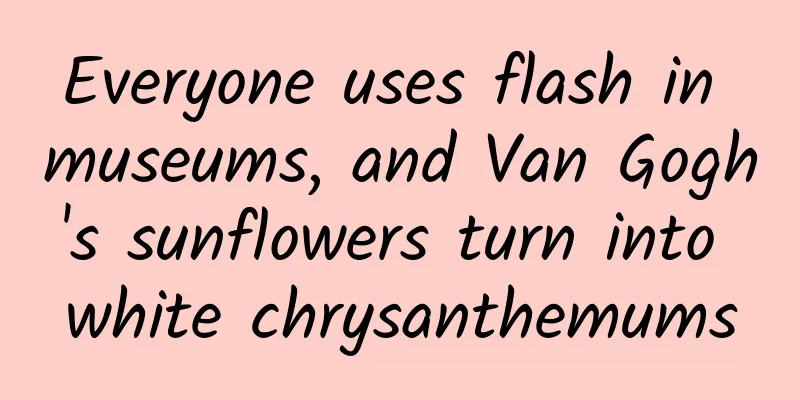Everyone uses flash in museums, and Van Gogh's sunflowers turn into white chrysanthemums

|
When visiting a museum, if you pay close attention, you may sometimes find signs prohibiting the use of flash. Why is it necessary to prohibit the use of flash in museums? Will using flash have any effect on the exhibits? The root of the problem: light carries energy All light contains energy, but this energy is one of the main culprits of the aging of cultural relics. The most lethal of these may be photochemical reactions: under the action of these energies, the molecules on the surface of cultural relics either decompose or react with other substances, thus losing their original characteristics. However, the energy of light is not equal. When light transmits energy, it is not continuous, but divided into small energy packets, each of which corresponds to a "photon". The bluer the light, the greater the energy of each photon, and generally speaking, the greater the photochemical damage caused; even if the total energy is the same, the redder the light, the less photochemical damage caused. Therefore, when paying attention to the impact of light on cultural relics, we need to pay attention to two points: one is the total energy carried by light, and the other is how many of the photons are high-energy and how many are low-energy. When discussing exhibited cultural relics, the former can be approximated by "illuminance" and the latter can be approximated by "color temperature". Light in the Museum | Unsplash Strictly speaking, the energy of light should be measured by radiation power. However, in daily life, we mainly use our eyes to receive light, and the most commonly used criterion is the brightness perceived by the eyes. Therefore, when discussing the energy of visible light, we often use "illuminance" - converting light intensity into the brightness perceived by the human eye. Strictly speaking, the distribution of photon energy should be measured using spectral information. However, museums and photography generally do not use strange light sources. Many common light sources can be approximated by ideal black bodies. Therefore, we use the corresponding temperature of a black body - "color temperature" to describe the energy status of photons: the higher the color temperature, the more high-energy photons there are, and the greater the photochemical destructive power. Flash light and the tolerance of exhibits It is of course ideal to keep cultural relics in pure darkness, but this will lose the educational and aesthetic significance of cultural relics. Good museums will strictly control the light source in the museum, so that visitors can see important details with their naked eyes and extend the life of cultural relics as much as possible; but no matter how good the control is, it will be shattered by external flash. So, what kind of light does the flash emit when taking pictures? Does it exceed the tolerance of the exhibits? Taking the most commonly used xenon flash lamp as an example, in order to understand its luminous properties in more detail, we discuss it in conjunction with the emission spectrum of the xenon flash lamp. As can be seen from the figure, in addition to the visible light region (400 nm - 700 nm), the xenon flash lamp also has two obvious emission regions, namely the ultraviolet region (200 nm - 400 nm) with shorter wavelengths and higher energy, and the infrared region (700 nm - 1200 nm) with longer wavelengths than red light and obvious thermal effects. Xenon flash lamp emission spectrum: the horizontal axis is the wavelength range, the vertical axis is the intensity | Reference [1] So do xenon flash lamps meet the requirements? First of all, let’s look at the color temperature. As an excellent substitute for sunlight, the color temperature of xenon lamps is similar to that of sunlight, generally around 6200K, which exceeds the requirements of collections that are sensitive to light. As a flash lamp, although the xenon lamp emits light for a very short time, its instantaneous illumination can reach tens of thousands of lux at a distance of 2 meters from the object - this is obviously far greater than the illumination value that the collection can withstand. Recommended values of illumination for exhibits | References [13] Light makes textiles look different Colorful fabrics rely on a variety of dyes, but the dyes themselves are fragile, making colorful fabrics more difficult to preserve. There are many reasons why dyes are so "delicate", and "photobleaching" is one of the main culprits. As the name suggests, dye photobleaching refers to the fading of dyes under the action of light. The mechanism is relatively complicated, but most studies have shown that dye photobleaching can be divided into two pathways: direct decomposition of dyes and oxidative decomposition. Direct decomposition generally requires high-energy ultraviolet light, and the conditions for occurrence are slightly harsh; while oxidative decomposition does not require high light, and oxygen is everywhere, so it is easy to occur under normal conditions. Dyes fade under light | Pinterest Depending on how the dye molecules react with oxygen after being photoactivated, the pathways of light-promoted oxidative decomposition can be divided into two types. The first way is that light activates oxygen through dye, and the activated oxygen in turn destroys the dye. In order to better understand these two ways, we need to first introduce a concept - energy level. For simple understanding, we can think of energy levels as floors of different heights. Although molecules like to stay at the stable bottom layer, once there is light, the dye molecules will absorb the appropriate light energy and jump to a higher level. On the other hand, although it is difficult for light to make oxygen in the bottom state "high", the dye molecules that have absorbed light energy will generously give light energy to oxygen and retreat to the bottom layer. The oxygen that has gained energy will jump to singlet oxygen with higher energy, oxidizing the dye cleanly. How singlet oxygen is produced Another way for light to promote oxidation is to directly produce free radical superoxide anions. At a more microscopic level, there are also different floors inside the molecule, and the tenants are electrons. When electrons absorb light energy, they jump to higher floors. The appearance of oxygen gives the restless high-level electrons a new place to go - the dye molecules activated by light will transfer electrons to oxygen, and they will be oxidized into free radical cations, while oxygen will be reduced to free radical superoxide anions. Free radical superoxide anions have both the activity of free radicals and the strong oxidizing property of oxygen, and will decompose the dye molecules completely. How superoxide anions are produced Although there were not so many artificial synthetic dyes in ancient times, people still obtained a wide variety of natural dyes from nature, such as indigo, anthocyanin, shikonin, and rutin. Indigo dyeing in ancient times relied on juice extracted from plants. In the dyeing process, in addition to indigo, indigo red, a molecule with a similar structure to indigo, was often produced due to changes in temperature and pH value during dyeing. Studies have found that ultraviolet light with a main wavelength of 365 nm has a significant degradation effect on indigo red in the dye. Textiles dyed with indigo | albanyinstitute.org In addition, indigo carmine in indigo dye will also quickly undergo oxidation and decomposition under the action of ultraviolet light and oxygen to produce indigo carmine sulfonic acid. Fabrics are often colored with various organic dyes, while paintings also use various inorganic pigments, such as lead white, cinnabar, etc. So, can collections using inorganic pigments escape the pursuit of flash? Unfortunately, no. For example, bright yellow paint uses a component called cadmium sulfide (CdS), which is widely popular among painters because of its strong coloring power, stability and bright color. Monet, Van Gogh, Picasso and other painters have used this pigment extensively in their works. However, under the action of visible light, the sulfur in cadmium sulfide will be gradually oxidized into sulfate. This process can still be explained by the energy level model mentioned earlier: light will drive the electrons in cadmium sulfide to higher floors, and once there is a vacant room, the electrons originally living in sulfur will take advantage of the opportunity to move in. As a result, sulfur loses electrons and is oxidized into elemental sulfur, which is easily oxidized into sulfate by oxygen, and eventually the pigment is completely destroyed. Cadmium sulfide (cadmium yellow) used in oil paintings丨webexhibits.org The damage caused by light to collections goes far beyond this - although infrared light has low energy, its significant thermal effect can accelerate the dehydration and cracking of cellulose-rich collections such as paper and wood; organic collections, such as animal and plant specimens, bone tools, etc., are rich in carbonyl, aromatic and other chromophores, which can also be excited under light conditions, oxidized, or simply decomposed directly. A small flash of a flashlight is certainly not as harsh as the simulated conditions in the laboratory, but the damage accumulated over time is enough to produce the effect of water dripping through a stone. In order to ensure that the weight of history can be passed down for thousands of years, please turn off the flashlight and carefully appreciate those precious collections! References [1] Batchelor, SN, et al. The photofading mechanism of commercial reactive dyes on cotton, Dyes and Pigments, 2003, 59, 269. [2] Oakes, J. Photofading of textile dyes, Review of Progress in Coloration and Related Topics, 2001, 31, 21. [3] Wilkinson, F., et al. Rate constants for the decay and reactions of the lowest electronically excited singlet state of molecular oxygen in solution. An expanded and revised compilation, Journal of Physical and Chemical Reference Data, 1995, 24, 663. [4] Egerton, GS, et al. The photochemistry of dyes. IV-The role of singlet oxygen and hydrogen peroxide in photosensitized degradation of polymers, Journal of the Society of Dyers and Colourists, 1971, 87, 268. [5] Bandara, J., et al. Fast kinetic spectroscopy, decoloration and production of H2O2 induced by visible light in oxygenated solutions of the azo dye Orange II, New Journal of Chemistry, 1999, 23, 717. [6] Roy, A. National Gallery Technical Bulletin, 2007, 28, 58. [7] Fiedler, I., et al. Cadmium yellows, oranges and reds. Artists'Pigments. A Handbook of their History and Characteristics; Cambridge University Press: Cambridge, 1986; Vol. 1, pp 65. [8] Leone, B., et al. The deterioration of cadmium sulphide yellow artists'pigments. In Preprints of The 14th Triennial Meeting of ICOM International Committee for Conservation; 2005; Vol. 2, pp 803. [9] http://dpanswers.com/content/canon_flash.php [10] http://www.cap-xx.com/resources/docs/cap-xx_wp_0906_comparison_of_xenon_flash_and_led_flash_v3.pdf [11] Wang Yongli, PhD thesis, Study on the influence of physical environment on the color and quality of ancient silk fabrics, Donghua University, 2007 [12] Saunders, D. Photographic Flash: Threat or Nuisance? National Gallery Technical Bulletin, 1995, 16, 66. [13] Museum Building Design Code JGJ66-91 [14] http://people.ds.cam.ac.uk/mhe1000/musphoto/flashphoto2.htm [15] Schaeffer., TT Effects of Light on Materials in Collections: Data on Photoflash and Related Sources, Getty Conservation Institute, Los Angeles, California: 2001 Author: winter_鼠包 Editor: Forgot Jianghu Title image source: @Ståle Grut / Unsplash |
<<: What should you eat and drink when you are infected with a virus and have a high fever?
>>: Third-hand smoke is everywhere
Recommend
Smart eating in winter - why should we pay attention to dark vegetables?
In the past, most of the food we consume is calle...
Cash stolen from Pinduoduo? After reading the WeChat emergency notification, it turns out that the culprit is Apple
How come my WeChat account was stolen when I was ...
Advertising and marketing creative poster collection
For every designer Posters are the most common an...
This is definitely the dumbest loophole in history
The college entrance examination scores of various...
Has Apple's car-making project failed? Analysts point out that the fastest way to success is acquisition
Apple has always had ambitions to enter the autom...
Is 2016 the year of VR explosion? Nvidia says you are overthinking it
The popularity of virtual reality has encountered...
Talk about user cognitive cost!
Let me first explain the general logic. Professor...
Where will Google take us?
As a winner of Toutiao's Qingyun Plan and Bai...
What wonders will happen when a matter sun and an antimatter sun collide?
This is an answer to a question invited by netize...
Has Taobao's "QuA" revolutionized online travel?
Taobao gave birth to another son, named "QuA...
iPad cutout is more powerful than PC. The automatic cutout of iPad version of PS is amazing.
Although Apple claims that the iPad Pro is a prod...
The latest Baidu promotion and traffic diversion skills in 2021, you can learn them in minutes
We have always said that traffic is the core of I...
Operation means having a love relationship with users!
My understanding of user operations Operational w...
Who makes the water smell bad? Find the culprits of the water odor
Water is the source of life. According to the &qu...
A Beginner's Guide to Brand Building
The purpose of brand naming is to empower "s...









